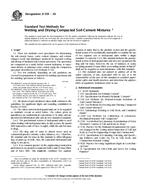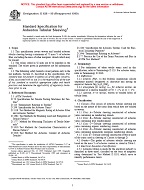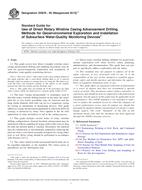1.1 This standard practice provides methodology to convert fracture strength parameters (primarily the mean strength and the Weibull characteristic strength) estimated from data obtained with one test geometry to strength parameters representing other test geometries. This practice addresses uniaxial strength data as well as some biaxial strength data. It may also be used for more complex geometries proved that the effective areas and effective volumes can be estimated. It is for the evaluation of Weibull probability distribution parameters for advanced ceramics that fail in a brittle fashion. Fig. 1 shows the typical variation of strength with size. The larger the specimen or component, the weaker it is likely to be.
1.2 As noted in Practice C 1239, the failure strength of advanced ceramics is treated as a continuous random variable. A number of functions may be used to characterize the strength distribution of brittle ceramics, but the Weibull distribution is the most appropriate especially since it permits strength scaling for the size of specimens or component. Typically, a number of test specimens with well-defined geometry are broken under well-defined loading conditions. The force at which each test specimen fails is recorded and fracture strength calculated. The strength values are used to obtain Weibull parameter estimates associated with the underlying population distribution.
1.3 This standard is restricted to the assumption that the distribution underlying the failure strengths is the two-parameter Weibull distribution with size scaling. The practice also assumes that the flaw population is stable with time and that no slow crack growth occurs.
1.4 This practice includes the following topics:
| Section | |
|---|---|
| Scope | 1 |
| Referenced Documents | 2 |
| Terminology | 3 |
| Summary of Practice | 4 |
| Significance and Use | 5 |
| Probability of Failure Relationships | 6 |
| Test Specimens with Uniaxial Stress States–Effective Volume and Area Relationships | 7 |
| Uniaxial Tensile Test Specimens | 7.1 |
| Rectangular Flexure Test Specimens | 7.2 |
| Round Flexure Test Specimens | 7.3 |
| C-Ring Test Specimens | 7.4 |
| Test Specimens with Multiaxial Stress States–Effective Volume and Area Relationships | 8 |
| Pressure-on-Ring Test Specimens | 8.1 |
| Ring-on-Ring Test Specimens | 8.2 |
| Examples of Converting Characteristic Strengths | 9 |
| Report | 10 |
| Precision and Bias | 11 |
| Keywords | 12 |
| Combined Gamma Function for Round Rods Tested in Flexure |
Annex A1 |
| Components or Test Specimens with Multiaxial Stress Distributions |
Annex A2 |
| Components or Test Specimens with Complex Geometries and Stress Distributions |
Annex A3 |
1.5 The values stated in SI units are to be regarded as the standard per IEEE/ASTM SI 10.
1.6 This standard does not purport to address all of the safety concerns, if any, associated with its use. It is the responsibility of the user of this standard to establish appropriate safety and health practices and determine the applicability of regulatory limitations prior to use.

FIG. 1 Strength Scales with Size
Product Details
- Published:
- 01/01/2008
- Number of Pages:
- 18
- File Size:
- 1 file , 310 KB


